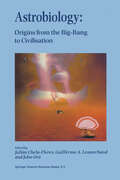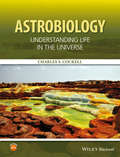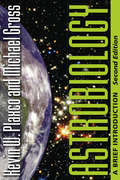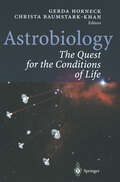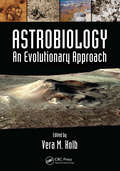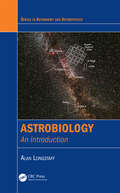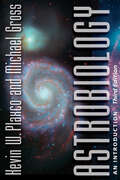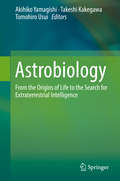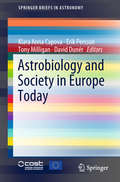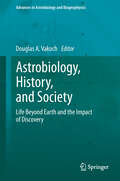- Table View
- List View
Astrobiology: Origins from the Big-Bang to Civilisation Proceedings of the Iberoamerican School of Astrobiology Caracas, Venezuela, 28 November– 8 December, 1999
by Julian Chela-Flores Guillermo A. Lemarchand John OróAstrobiology: Understanding Life in the Universe (Physical Chemistry In Action Ser.)
by Charles S. CockellAstrobiology is an interdisciplinary field that asks profound scientific questions. How did life originate on the Earth? How has life persisted on the Earth for over three billion years? Is there life elsewhere in the Universe? What is the future of life on Earth?Astrobiology: Understanding Life in the Universe is an introductory text which explores the structure of living things, the formation of the elements for life in the Universe, the biological and geological history of the Earth and the habitability of other planets in our own Solar System and beyond. The book is designed to convey some of the major conceptual foundations in astrobiology that cut across a diversity of traditional fields including chemistry, biology, geosciences, physics and astronomy. It can be used to complement existing courses in these fields or as a stand-alone text for astrobiology courses. Readership: Undergraduates studying for degrees in earth or life sciences, physics, astronomy and related disciplines, as well as anyone with an interest in grasping some of the major concepts and ideas in astrobiology.
Astrobiology: Understanding Life in the Universe
by Charles S. CockellAstrobiology is an interdisciplinary field that asks profound scientific questions. How did life originate on the Earth? How has life persisted on the Earth for over three billion years? Is there life elsewhere in the Universe? What is the future of life on Earth?Astrobiology: Understanding Life in the Universe is an introductory text which explores the structure of living things, the formation of the elements for life in the Universe, the biological and geological history of the Earth and the habitability of other planets in our own Solar System and beyond. The book is designed to convey some of the major conceptual foundations in astrobiology that cut across a diversity of traditional fields including chemistry, biology, geosciences, physics and astronomy. It can be used to complement existing courses in these fields or as a stand-alone text for astrobiology courses. Readership: Undergraduates studying for degrees in earth or life sciences, physics, astronomy and related disciplines, as well as anyone with an interest in grasping some of the major concepts and ideas in astrobiology.
Astrobiology: Understanding Life in the Universe (Physical Chemistry In Action Ser.)
by Charles S. CockellA guide to understanding the formation of life in the Universe The revised and updated second edition of Astrobiology offers an introductory text that explores the structure of living things, the formation of the elements required for life in the Universe, the biological and geological history of the Earth, and the habitability of other planets. Written by a noted expert on the topic, the book examines many of the major conceptual foundations in astrobiology, which cover a diversity of traditional fields including chemistry, biology, geosciences, physics, and astronomy. The book explores many profound questions such as: How did life originate on Earth? How has life persisted on Earth for over three billion years? Is there life elsewhere in the Universe? What is the future of life on Earth? Astrobiology is centered on investigating the past and future of life on Earth by looking beyond Earth to get the answers. Astrobiology links the diverse scientific fields needed to understand life on our own planet and, potentially, life beyond. This new second edition: Expands on information about the nature of astrobiology and why it is useful Contains a new chapter “What is Life?” that explores the history of attempts to understand life Contains 20% more material on the astrobiology of Mars, icy moons, the structure of life, and the habitability of planets New ‘Discussion Boxes’ to stimulate debate and thought about key questions in astrobiology New review and reflection questions for each chapter to aid learning New boxes describing the careers of astrobiologists and how they got into the subject Offers revised and updated information throughout to reflect the latest advances in the field Written for students of life sciences, physics, astronomy and related disciplines, the updated edition of Astrobiology is an essential introductory text that includes recent advances to this dynamic field.
Astrobiology: Understanding Life in the Universe
by Charles S. CockellA guide to understanding the formation of life in the Universe The revised and updated second edition of Astrobiology offers an introductory text that explores the structure of living things, the formation of the elements required for life in the Universe, the biological and geological history of the Earth, and the habitability of other planets. Written by a noted expert on the topic, the book examines many of the major conceptual foundations in astrobiology, which cover a diversity of traditional fields including chemistry, biology, geosciences, physics, and astronomy. The book explores many profound questions such as: How did life originate on Earth? How has life persisted on Earth for over three billion years? Is there life elsewhere in the Universe? What is the future of life on Earth? Astrobiology is centered on investigating the past and future of life on Earth by looking beyond Earth to get the answers. Astrobiology links the diverse scientific fields needed to understand life on our own planet and, potentially, life beyond. This new second edition: Expands on information about the nature of astrobiology and why it is useful Contains a new chapter “What is Life?” that explores the history of attempts to understand life Contains 20% more material on the astrobiology of Mars, icy moons, the structure of life, and the habitability of planets New ‘Discussion Boxes’ to stimulate debate and thought about key questions in astrobiology New review and reflection questions for each chapter to aid learning New boxes describing the careers of astrobiologists and how they got into the subject Offers revised and updated information throughout to reflect the latest advances in the field Written for students of life sciences, physics, astronomy and related disciplines, the updated edition of Astrobiology is an essential introductory text that includes recent advances to this dynamic field.
Astrobiology: A Brief Introduction
by Michael Gross Kevin W. PlaxcoInformed by new planetary discoveries and the findings from recent robotic missions to Mars, Jupiter, and Saturn, scientists are rapidly replacing centuries of speculation about potential extraterrestrial habitats with real knowledge about the possibility of life outside our own biosphere—if it exists, and where. This second edition of Kevin W. Plaxco and Michael Gross’s widely acclaimed text incorporates the latest research in astrobiology to bring readers the most comprehensive, up-to-date, and engaging introduction to the field available.Plaxco and Gross expand their examination of the origin of chemical elements, the developments that made the Universe habitable, and how life continues to be sustained. They discuss in great detail the formation of the first galaxies and stars, the diverse chemistry of the primordial planet, the origins of metabolism, the evolution of complex organisms, and the feedback regulation of Earth's climate. They also explore life in extreme habitats, potential extraterrestrial habitats, and the current status of the search for extraterrestrial life.Weaving together the relevant threads of astronomy, geology, chemistry, biophysics, and microbiology, this broadly accessible introductory text captures the excitement, controversy, and progress of the dynamic young field of astrobiology. New to this edition is a glossary of terms and an epilogue recapping the key unanswered questions, making Astrobiology an ideal primer for students and, indeed, for anyone curious about life and the Universe.
Astrobiology: The Quest for the Conditions of Life
by Gerda Horneck Christa Baumstark-KhanThis book bridges a gap in the literature by bringing together leading specialists from different backgrounds. It addresses the specific need for a readable book on this very interdisciplinary and new topic at research level.
Astrobiology: An Evolutionary Approach
by Vera M. KolbAstrobiology: An Evolutionary Approach provides a full course in astrobiology with an emphasis on abiogenesis and evolution. The book presents astrobiology both as a developing science and as the science of the future.The origins of life and the possibility of life elsewhere continues to be a subject of scientific and philosophical examination. The
Astrobiology: An Introduction (Series In Astronomy And Astrophysics Ser.)
by Alan LongstaffAstrobiology is a multidisciplinary pursuit that in various guises encompasses astronomy, chemistry, planetary and Earth sciences, and biology. It relies on mathematical, statistical, and computer modeling for theory, and space science, engineering, and computing to implement observational and experimental work. Consequently, when studying astrobio
Astrobiology: The Search for Life Elsewhere in the Universe (Hot Science)
by Andrew MayExtraterrestrial life is a common theme in science fiction, but is it a serious prospect in the real world? Astrobiology is the emerging field of science that seeks to answer this question. The possibility of life elsewhere in the cosmos is one of the most profound subjects that human beings can ponder. Astrophysicist Andrew May gives an expert overview of our current state of knowledge, looking at how life started on Earth, the tell-tale ‘signatures’ it produces, and how such signatures might be detected elsewhere in the Solar System or on the many ‘exoplanets’ now being discovered by the Kepler and TESS missions. Along the way the book addresses key questions such as the riddle of Fermi’s paradox (‘Where is everybody?’) and the crucial role of DNA and water – they’re essential to ‘life as we know it’, but is the same true of alien life? And the really big question: when we eventually find extraterrestrials, will they be friendly or hostile?
Astrobiology: Science, Ethics, and Public Policy (Astrobiology Perspectives on Life in the Universe #19)
by Octavio Alfonso Chon Torres Ted Peters Joseph Seckbach Richard GordonASTROBIOLOGY This unique book advances the frontier discussion of a wide spectrum of astrobiological issues on scientific advances, space ethics, social impact, religious meaning, and public policy formulation. Astrobiology is an exploding discipline in which not only the natural sciences, but also the social sciences and humanities converge. Astrobiology: Science, Ethics, and Public Policy is a multidisciplinary book that presents different perspectives and points of view by its contributing specialists. Epistemological, moral and political issues arising from astrobiology, convey the complexity of challenges posed by the search for life elsewhere in the universe. We ask: if a convoy of colonists from Earth make the trip to Mars, should their genomes be edited to adapt to the Red Planet’s environment? If scientists discover a biosphere with microbial life within our solar system, will it possess intrinsic value or merely utilitarian value? If astronomers discover an intelligent civilization on an exoplanet elsewhere in the Milky Way, what would be humanity’s moral responsibility: to protect Earth from an existential threat? To treat other intelligences with dignity? To exploit through interstellar commerce? To conquer? Audience The book will attract readers from a wide range of interests including astronomers, astrobiologists, chemists, biologists, space engineers, ethicists, theologians and philosophers.
Astrobiology: A Brief Introduction
by Kevin W. Plaxco Michael GrossInformed by new planetary discoveries and the findings from recent robotic missions to Mars, Jupiter, and Saturn, scientists are rapidly replacing centuries of speculation about potential extraterrestrial habitats with real knowledge about the possibility of life outside our own biosphere—if it exists, and where. This second edition of Kevin W. Plaxco and Michael Gross’s widely acclaimed text incorporates the latest research in astrobiology to bring readers the most comprehensive, up-to-date, and engaging introduction to the field available.Plaxco and Gross expand their examination of the origin of chemical elements, the developments that made the Universe habitable, and how life continues to be sustained. They discuss in great detail the formation of the first galaxies and stars, the diverse chemistry of the primordial planet, the origins of metabolism, the evolution of complex organisms, and the feedback regulation of Earth's climate. They also explore life in extreme habitats, potential extraterrestrial habitats, and the current status of the search for extraterrestrial life.Weaving together the relevant threads of astronomy, geology, chemistry, biophysics, and microbiology, this broadly accessible introductory text captures the excitement, controversy, and progress of the dynamic young field of astrobiology. New to this edition is a glossary of terms and an epilogue recapping the key unanswered questions, making Astrobiology an ideal primer for students and, indeed, for anyone curious about life and the Universe.
Astrobiology: An Introduction
by Kevin W. Plaxco Michael GrossExploring the potential for extraterrestrial life and the origins of our own planet, this comprehensive introduction to astrobiology is updated with the latest findings.Informed by the discoveries and analyses of extrasolar planets and the findings from recent robotic missions across the solar system, scientists are rapidly replacing centuries of speculation about potential extraterrestrial habitats with real knowledge about the possibility of life outside our own biosphere—if it exists, and, if so, where. Casting new light on the biggest questions there are—how did we get here, and who else might be out there?—this third edition of Kevin W. Plaxco and Michael Gross's widely acclaimed Astrobiology incorporates a decade's worth of new developments in space to bring readers the most comprehensive, up-to-date, and engaging introduction to the field available.Plaxco and Gross examine the factors that make our Universe habitable, from the origin of chemical elements and the formation of the first galaxies and stars to the birth and composition of the planets. They describe the latest thinking about the origins of life, explain the evolution of metabolism and the development of complex organisms. In order to assess the limits for life elsewhere, they also explore life in extreme habitats and reveal how it informs the search for potential extraterrestrial habitats—ones that might support extraterrestrial life. New and updated illustrations enhance the book throughout.Sharing fascinating findings from the comet mission Dawn, the visit of New Horizons to Pluto, and the work of the Deep Carbon Observatory, which has revealed an incredible underground biosphere within our own planet, Plaxco and Gross weave together cosmology, astrophysics, geology, biochemistry, biophysics, and microbiology. From neutron star mergers to the survival skills of tardigrades, this fascinating book is an ideal primer for students or anyone curious about life and the Universe.
Astrobiology: An Introduction
by Kevin W. Plaxco Michael GrossExploring the potential for extraterrestrial life and the origins of our own planet, this comprehensive introduction to astrobiology is updated with the latest findings.Informed by the discoveries and analyses of extrasolar planets and the findings from recent robotic missions across the solar system, scientists are rapidly replacing centuries of speculation about potential extraterrestrial habitats with real knowledge about the possibility of life outside our own biosphere—if it exists, and, if so, where. Casting new light on the biggest questions there are—how did we get here, and who else might be out there?—this third edition of Kevin W. Plaxco and Michael Gross's widely acclaimed Astrobiology incorporates a decade's worth of new developments in space to bring readers the most comprehensive, up-to-date, and engaging introduction to the field available.Plaxco and Gross examine the factors that make our Universe habitable, from the origin of chemical elements and the formation of the first galaxies and stars to the birth and composition of the planets. They describe the latest thinking about the origins of life, explain the evolution of metabolism and the development of complex organisms. In order to assess the limits for life elsewhere, they also explore life in extreme habitats and reveal how it informs the search for potential extraterrestrial habitats—ones that might support extraterrestrial life. New and updated illustrations enhance the book throughout.Sharing fascinating findings from the comet mission Dawn, the visit of New Horizons to Pluto, and the work of the Deep Carbon Observatory, which has revealed an incredible underground biosphere within our own planet, Plaxco and Gross weave together cosmology, astrophysics, geology, biochemistry, biophysics, and microbiology. From neutron star mergers to the survival skills of tardigrades, this fascinating book is an ideal primer for students or anyone curious about life and the Universe.
Astrobiology: Science, Ethics, and Public Policy (Astrobiology Perspectives on Life in the Universe)
by Joseph Seckbach Octavio A. Chon Torres Richard Gordon Ted PetersAstrobiology is an exploding discipline in which not only the natural sciences, but also the social sciences and humanities converge. Astrobiology: Science, Ethics and Public Policy is a multidisciplinary book that presents different perspectives and points of view by its contributing specialists. Epistemological, moral and political issues arising from astrobiology, convey the complexity of challenges posed by the search for life elsewhere in the universe. We ask: if a convoy of colonists from Earth make the trip to Mars, should their genomes be edited to adapt to the Red Planet’s environment? If scientists discover a biosphere with microbial life within our solar system, will it possess intrinsic value or merely utilitarian value? If astronomers discover an intelligent civilization on an exoplanet elsewhere in the Milky Way, what would be humanity’s moral responsibility: to protect Earth from an existential threat? To treat other intelligences with dignity? To exploit through interstellar commerce? To conquer?
Astrobiology: From the Origins of Life to the Search for Extraterrestrial Intelligence
by Akihiko Yamagishi Takeshi Kakegawa Tomohiro UsuiThis book provides concise and cutting-edge reviews in astrobiology, a young and still emerging multidisciplinary field of science that addresses the fundamental questions of how life originated and diversified on Earth, whether life exists beyond Earth, and what is the future for life on Earth. Readers will find coverage of the latest understanding of a wide range of fascinating topics, including, for example, solar system formation, the origins of life, the history of Earth as revealed by geology, the evolution of intelligence on Earth, the implications of genome data, insights from extremophile research, and the possible existence of life on other planets within and beyond the solar system. Each chapter contains a brief summary of the current status of the topic under discussion, sufficient references to enable more detailed study, and descriptions of recent findings and forthcoming missions or anticipated research. Written by leading experts in astronomy, planetary science, geoscience, chemistry, biology, and physics, this insightful and thought-provoking book will appeal to all students and scientists who are interested in life and space.
Astrobiology and Cuatro Ciénegas Basin as an Analog of Early Earth (Cuatro Ciénegas Basin: An Endangered Hyperdiverse Oasis)
by Valeria Souza Antígona Segura Jamie S. FosterAstrobiology not only investigates how early life took hold of our planet but also life on other planets – both in our Solar System and beyond – and their potential for habitability. The book take readers from the scars on planetary surfaces made by space rocks to the history of the Solar System narrated by those space rocks as well as exoplanets in other planetary systems. But the true question is how life arose here or elsewhere. Modern comparative genomics has revealed that Darwin was correct; a set of highly conserved genes and cellular functions indicate that all life is related by common ancestry. The Last Universal Common Ancestor or LUCA sits at the base of the Tree of Life. However, once that life took hold, it started to diversify and form complex microbial communities that are known as microbial mats and stromatolites. Due to their long evolutionary history and abundance on modern Earth, research on the biological, chemical and geological processes of stromatolite formation has provided important insights into the field of astrobiology. Many of these microbialite-containing ecosystems have been used as models for astrobiology, and NASA mission analogs including Shark Bay, Pavilion and Kelly Lakes. Modern microbialites represent natural laboratories to study primordial ecosystems and provide proxies for how life could evolve on other planets. However, few viral metagenomic studies (i.e., viromes) have been conducted in microbialites, which are not only an important part of the community but also mirror its biodiversity.This book focuses on particularly interesting sites such as Andean lake microbialites, a proxy of early life since they are characterized by very high UV light, while Alchichica and Bacalar lakes are characterized by high-salt and oligotrophic waters that nurture stromatolites. However, it is only the oasis of Cuatro Ciénegas Basin in México that stored past life in its marine sediments of the Sierra de San Marcos. This particular Sierra has a magmatic pouch that moves the deep aquifer to the surface in a cycle of sun drenched life and back to the depths of the magmatic life in an ancient cycle that now is broken by the overexploitation of the surface water as well as the deep aquifer in order to irrigate alfalfa in the desert. The anthropocene, the era of human folly, is killing this unique time machine and with it the memory of the planet.
Astrobiology and Society in Europe Today (SpringerBriefs in Astronomy)
by Klara Anna Capova Erik Persson Tony Milligan David DunérThis White Paper describes the state of astrobiology in Europe today and its relation to the European society at large. With contributions from authors in twenty countries and over thirty scientific institutions worldwide, the document illustrates the societal implications of astrobiology and the positive contribution that astrobiology can make to European society. The White paper has two main objectives: 1. It recommends the establishment of a European Astrobiology Institute (EAI) as an answer to a series of challenges relating to astrobiology but also European research, education and the society at large. 2. It also acknowledges the societal implications of astrobiology, and thus the role of the social sciences and humanities in optimizing the positive contribution that astrobiology can make to the lives of the people of Europe and the challenges they face.This book is recommended reading for science policy makers, the interested public, and the astrobiology community.
Astrobiology: Future Perspectives (Astrophysics and Space Science Library #305)
by Didier Despois Antonio Lazcano Francois Robert P. Ehrenfreund T. Owen W. M. Irvine Luann Becker Jen Blank J. R. Brucato Luigi Colangeli Sylvie Derenne Anne DutreyAstrobiology, a new exciting interdisciplinary research field, seeks to unravel the origin and evolution of life wherever it might exist in the Universe. The current view of the origin of life on Earth is that it is strongly connected to the origin and evolution of our planet and, indeed, of the Universe as a whole. We are fortunate to be living in an era where centuries of speculation about the two ancient and fundamental problems: the origin of life and its prevalence in the Universe are being replaced by experimental science. The subject of Astrobiology can be approached from many different perspectives. This book is focused on abiogenic organic matter from the viewpoint of astronomy and planetary science and considers its potential relevance to the origins of life on Earth and elsewhere. Guided by the review papers in this book, the concluding chapter aims to identify key questions to motivate future research and stimulate astrobiological applications of current and future research facilities and space missions. Today’s rich array of new spacecraft, telescopes and dedicated scientists promises a steady flow of discoveries and insights that will ultimately lead us to the answers we seek.
Astrobiology, History, and Society: Life Beyond Earth and the Impact of Discovery (Advances in Astrobiology and Biogeophysics)
by Douglas A. VakochThis book addresses important current and historical topics in astrobiology and the search for life beyond Earth, including the search for extraterrestrial intelligence (SETI). The first section covers the plurality of worlds debate from antiquity through the nineteenth century, while section two covers the extraterrestrial life debate from the twentieth century to the present. The final section examines the societal impact of discovering life beyond Earth, including both cultural and religious dimensions. Throughout the book, authors draw links between their own chapters and those of other contributors, emphasizing the interconnections between the various strands of the history and societal impact of the search for extraterrestrial life.The chapters are all written by internationally recognized experts and are carefully edited by Douglas Vakoch, professor of clinical psychology at the California Institute of Integral Studies and Director of Interstellar Message Composition at the SETI Institute.This interdisciplinary book will benefit everybody trying to understand the meaning of astrobiology and SETI for our human society.
Astrobiology on the International Space Station (SpringerBriefs in Space Life Sciences)
by Jean-Pierre de VeraThis volume on astrobiology of the Springer Briefs in Life Sciences book series addresses the three fundamental questions on origin, evolution, distribution and future of life in the universe: how does life begin and evolve? Is there life beyond Earth and, if so, how can we detect it? What is the future of life on Earth and in the universe? The book provides insights into astrobiological experiments that are being performed on the International Space Station, ISS, and discusses their findings.This extremely exciting volume on astrobiology is intended for scientists of various research fields and for laypersons interested in space research and in the fundamental issues of the universe and life.
Astrobiology: A Very Short Introduction (Very Short Introductions)
by David C. CatlingAstrobiology is the study of the origin and development of life on this and other planets. What fascinates people about astrobiology is that it seeks answers to long-standing unsolved questions: How quickly did life evolve on Earth and why did life persist here? Is there life elsewhere in the Solar System or beyond? The research of astrobiology has become more crucial than ever in recent decades, as biologists have discovered microbes that live in ever more extreme settings, such as bubbling hot springs, in acid, or deep within rocks. Rooted in strong and rigorous research, astrobiology incorporates the work of microbiologists, geologists, and astronomers. In this Very Short Introduction, David C. Catling introduces the origins of astrobiology and demonstrates its impact on current astronomical research and potential future discoveries. ABOUT THE SERIES: The Very Short Introductions series from Oxford University Press contains hundreds of titles in almost every subject area. These pocket-sized books are the perfect way to get ahead in a new subject quickly. Our expert authors combine facts, analysis, perspective, new ideas, and enthusiasm to make interesting and challenging topics highly readable.
Astrochemistry: From Astronomy to Astrobiology
by Andrew M. ShawThe dynamic field of astrochemistry brings together ideas of physics, astrophysics, biology and chemistry to the study of molecules between stars, around stars and on planets. Astrochemistry: from Astronomy to Astrobiology provides a clear and concise introduction to this rapidly evolving multidisciplinary subject. Starting with the Molecular Universe, the text covers the formation of the elements, simple models of stars and their classification. It then moves on to draw on the theme of the Origins of Life to study interstellar chemistry, meteorite and comet chemistry as well as the chemistry of planets. Prebiotic chemistry and astrobiology are explored by examining the extremes of the biosphere on Earth, seeing how this may be applied to life in other solar systems. Astrochemsitry assumes a basic familiarity with principles of physical and organic chemistry but no prior knowledge of biology or astrophysics. This innovative text incorporates results from the latest research and ground and space missions, with key images enhanced by a colour plate section. includes latest research and results from ground and space missions colour plate section summary of concepts and calculations at the end of each chapter accompanying website www.wiley.co/go/shawastrochemistry This book will be an ideal text for an undergraduate course in Astrochemistry and an essential tool for postgraduates entering the field.
Astrochemistry: The Physical Chemistry of the Universe
by Andrew M. ShawA fully revised new edition of an introductory text to the dynamic and fascinating subject of astrochemistry Since the first edition in 2006 of Astrochemistry, the Mars rovers have driven 31.18 miles, there has been fly-by of Pluto changing it from a 4-pixel world on the Hubble Space Telescope into a mysterious non-planet. There have been visits to asteroids, revisiting Mercury, discovery of the Higgs Boson, discovery of over 2000 extrasolar planets and landing on the comet 67P/Churyumov–Gerasimenko by Rosetta mission – hence the timely publication of this new edition. This core textbook now includes more detailed information on the kinetic modelling of chemistry in the interstellar medium, extending the same principles of physical chemistry to meteor ablation and finally atmospheres and oceans. The increase in density from near-emptiness to 1.35 × 1021 L of water in the world’s oceans is used to take single collision kinetics into ensemble thermodynamics. A new introduction of thermodynamic using meteor ablation replaces traditional bomb calorimetry and per-biotic chemistry leads to spontaneous reactions. New to the second edition: An extended discussion on matter, dark or otherwise, interstellar and stellar chemistry and the origin of pre-biotic molecules Detailed chemical kinetic models for mechanisms of chemistry in the interstellar medium Origins of life in solution, enzyme kinetics and catalysis A review of Mars and Titan as habitats for life Fully referenced throughout to reflect the research frontier An introduction to the idea of analytical mathematical engines that can do all of the heavy mathematics and fostering the skill of setting up a model and testing it 200 problems with detailed solutions Written for undergraduate and postgraduate students in astrochemistry or more generally physical chemistry, the new edition of Astrochemistry is an important introductory text to the topic, the latest developments in the field and the
Astrochemistry: The Physical Chemistry of the Universe
by Andrew M. ShawA fully revised new edition of an introductory text to the dynamic and fascinating subject of astrochemistry Since the first edition in 2006 of Astrochemistry, the Mars rovers have driven 31.18 miles, there has been fly-by of Pluto changing it from a 4-pixel world on the Hubble Space Telescope into a mysterious non-planet. There have been visits to asteroids, revisiting Mercury, discovery of the Higgs Boson, discovery of over 2000 extrasolar planets and landing on the comet 67P/Churyumov–Gerasimenko by Rosetta mission – hence the timely publication of this new edition. This core textbook now includes more detailed information on the kinetic modelling of chemistry in the interstellar medium, extending the same principles of physical chemistry to meteor ablation and finally atmospheres and oceans. The increase in density from near-emptiness to 1.35 × 1021 L of water in the world’s oceans is used to take single collision kinetics into ensemble thermodynamics. A new introduction of thermodynamic using meteor ablation replaces traditional bomb calorimetry and per-biotic chemistry leads to spontaneous reactions. New to the second edition: An extended discussion on matter, dark or otherwise, interstellar and stellar chemistry and the origin of pre-biotic molecules Detailed chemical kinetic models for mechanisms of chemistry in the interstellar medium Origins of life in solution, enzyme kinetics and catalysis A review of Mars and Titan as habitats for life Fully referenced throughout to reflect the research frontier An introduction to the idea of analytical mathematical engines that can do all of the heavy mathematics and fostering the skill of setting up a model and testing it 200 problems with detailed solutions Written for undergraduate and postgraduate students in astrochemistry or more generally physical chemistry, the new edition of Astrochemistry is an important introductory text to the topic, the latest developments in the field and the
